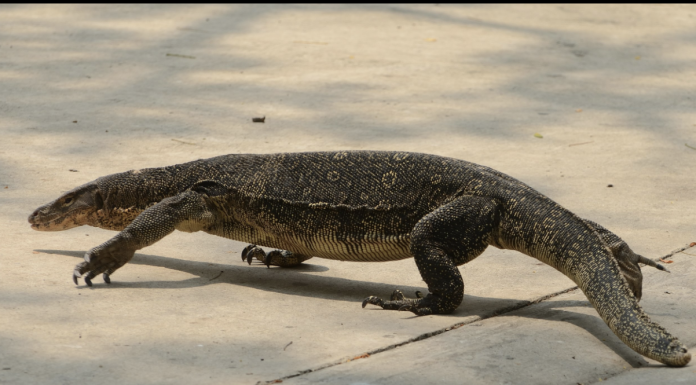
Sep 22, 2020 |
AP – A Florida man has been sentenced to 90 days of home detention and 288 hours of community service for his part in a trafficking scheme in which live water monitor lizards were stuffed into socks and concealed inside electronics to be smuggled from the Philippines to the United States.
Akbar Akram, 44, was sentenced earlier this month in Tampa federal court. He pleaded guilty in January to one count of wildlife trafficking in violation of the Lacey Act and the Convention on International Trade in Endangered Species Treaty, court records show.
Akram admitted to illegally importing more than 20 live water monitor lizards from the Philippines in 2016, a U.S. Justice Department statement said. He avoided customs authorities by placing the lizards in socks, which were sealed closed with tape and concealed inside electronic equipment and shipped under a false label.
The equipment was transported through commercial carriers to Akram’s associate in Massachusetts. As part of his plea, Akram admitted that he knew the monitor lizards he received had been taken in violation of Philippine law and that the import violated U.S. law, according to the statement.
Akram also admitted that upon receiving the monitor lizards, he sold some of them to customers in Colorado, Connecticut and Massachusetts. Approximately 70 monitor lizard species are characterized by elongated necks, heavy bodies, long-forked tongues, strong claws and long tails. Water monitor lizards are native to South and Southeastern Asia. The yellow-headed water monitor, the white-headed water monitor and the marbled water monitor are found in the Philippines.

DEATH BY LIZARD
Ronald Huff who was eaten by his pet monitor lizards ‘was killed by the 6ft creatures when a BITE became infected’
Man had his face, hands, and stomach organs devoured by seven 6ft-long Nile monitor lizards he let roam free in his flat.
29 Mar 2018
The Sun (UK) – A man eaten by his pet monitor lizards was also KILLED by the creatures because he succumbed to a blood infection caused by their bites, it is claimed.
Ronald Huff, 42, had his face, hands and stomach organs devoured by seven 6ft-long Nile monitor lizards he let roam free in his flat.

The huge reptiles – flesh-eating, venomous and endemic to Africa – were found by cops covered in their owner’s blood and were hissing aggressively at the officers.
To date Ronald’s 2002 death remains one of the most terrifying and bizarre instances of a human being eaten by their pets.
Neighbour Jeff Wildonger, now aged 38, told The Sun Online: “If he didn’t have those lizards there he’d be alive today, there’s no doubt.”
Ronald’s body was found by cops propped up against the front door of the apartment with the enormous lizards feasting on his corpse.
It later emerged the lizards had been allowed to roam freely throughout his home. Source.
7 of the World’s Most Dangerous Lizards and Turtles
Brittanica – To many people, lizards and turtles are bizarre-looking creatures.
Many lizards are considered menacing because of their seemingly expressionless faces combined with their claws and teeth, whereas turtles are thought of as slow-moving, docile creatures.
Most lizards, in reality, are harmless to humans, as are most turtles; however, there are certain members of both groups that can kill, maim, make ill, or inflict at least mild levels of pain on their hapless human victims.
Some lizards are, in fact, venomous, and some are quite aggressive.
The Malayan, or common, water monitor (second on this list only to its larger cousin, the Komodo dragon) is native to the Greater Sunda Islands and coastal areas of the Bay of Bengal and the South China Sea from Sri Lanka through southern China.
As with other monitor lizards, the Malayan water monitor has an elongated head and neck, a relatively heavy body, a long tail, and well-developed legs. Their tongues are long, forked, and snakelike, and adults can grow to 2.7 meters (9 feet).
Common water monitors are carnivorous and often consume large insects and spiders, other lizards, small mammals, fish, mollusks, and birds.
These lizards do not surprise their prey; they actively pursue their prey by swimming, climbing, or running after them. They also eat carrion and corpses of human beings, which they have been known to excavate and devour. People have hunted this species for food and their skins, which are used in traditional medicine and leather products.
Humans bitten by common water monitors may be injected with venom, which produces a mild, but not fatal effect, as well as exposed to infectious bacteria. This monitor can also use its whip-like tail and sharp claws as weapons. Although some reports of people dying from attacks by large individuals exist, they are probably untrue. Source.
PREVIOUSLY:
“I’m Bleeding To Death!” – Florida Pet Owner’s Frantic 9-1-1 Call
Pet Bird Kills Woman With Varicose Veins
Vicious Attacks Turn Gated Waterfront Into “Gator Waterfront”
ALSO ON HEADLINE HEALTH TODAY: ‘Uncle Ben’ Canceled | Clinton, Maxwell Secret Meeting | Cruz Nixes Resolution Honoring Ginsburg



